Peggy's Weather Report from Hallet Lake Camp:
Time: 8:30 am Temperature: 12.4 C or 54.5 F Humidity: 57.0% Wind: 12.0 km/hr from South Clouds: Cumulus and stratocumulus Cloud Cover: 90% overcast Light level: off scale (above 2000 X 10 Lux) At 6 am it was time to head to the kitchen tent for breakfast of a variety of cereal, fruit, and great coffee. Then out to finish business. We trolled for an hour on the lake conducting a plankton tow.
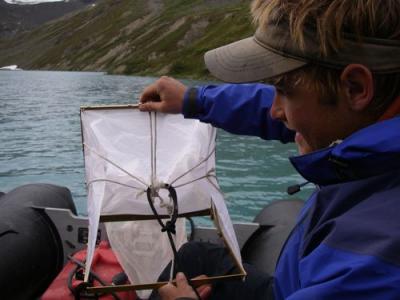
During that time, a grizzly on the shore opposite where we are camped came lumbering down the hill and eventually noticed us out on the lake. He was a beautiful golden bear who continued down and across the mountain. It was steep and he often slipped on the rocky slopes sliding down until he caught himself and continued on. He eventually saw us and stopped. He moved close to the lake edge and sniffed the air trying to detect our scent. As we trolled along doing the tow he followed on the shoreline for awhile. After awhile he moved on up the hill and over. I hoped there were no curious bears on our side of the lake!
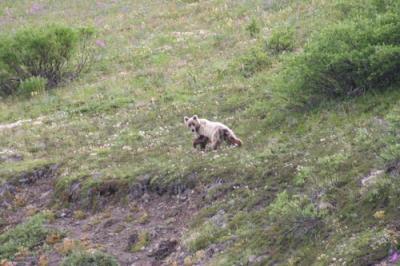
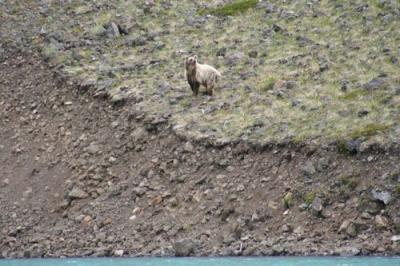
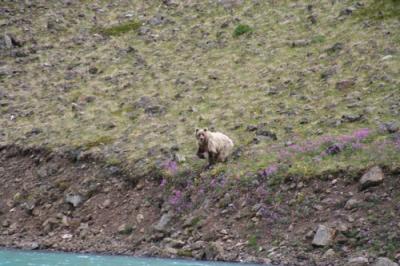
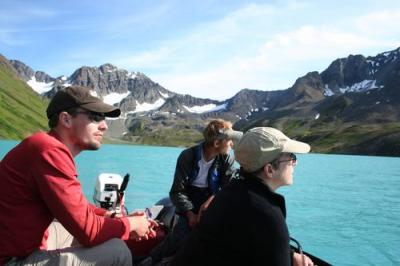
We finished the tow, collected the sample in a baggie and then condensed the critters down into a tube. There were some copepods and something similar to water fleas. Red was their primary color. They will be sent back to NAU to be ID’d.
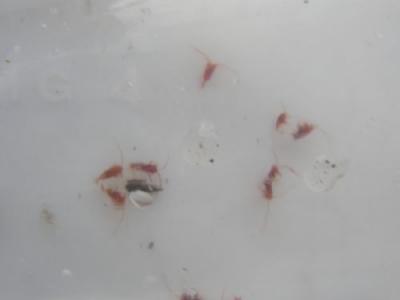
The last task was to set up an air temperature station at camp. The station set up last year was knocked down and brought back to our pilot Jerry, who kept it for the team. It was a little bent and the screws to attach it were gone. Caleb was trying to figure out a way to set it up without a post and attach it without screws. He found a tree that fit the bill, but attaching it was now the issue. Isolated from any stores, all we could do was look at what was at hand and improvise. Through team discussion and available resources, a way was found to attach the device to the tree.
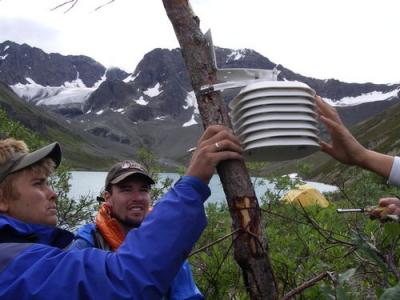
Caleb set the temperature logger on my computer to start logging. Later he would retrieve it to be certain it worked. The logger that was in the temperature station last year had only logged temperature for two days, which was a disappointment to the team.
Chris took water measurements and this is what he found:
Hallet Lake:pH 7.35, Conductivity 87.4 microSiemens, Temperature 10.7 C
Inflow stream: pH 6.85, Conductivity 86.9 microSiemens, Temperatue 3.2 C
The lake is warmer than the stream and the pH is a little less, or acidic in the stream. What could cause these differences…? Back to the tent for lunch before the hike.
The animals we have seen here are the Arctic ground squirrel, the grizzly, a small finch-like bird in the bushes, the Common Redpoll, a few Least Sandpipers swimming along the edge of the lake, and a loon. No Arctic terns here. Caleb and Heidi saw a porcupine while on a hike. He is camouflaged well. Can you see him?
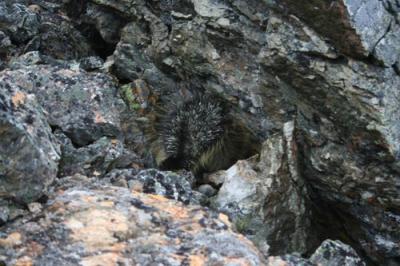
So we took off in the boat with bear flares, spray, and rifle, towards the glaciers and parked it at the end of the lake. We headed up the loose dry rocks left behind by the receding glacier. It was quite slippery and we had to work our way up. The way up was tough for me but we made it to the edge of the lateral moraine of one of the glaciers. What incredible views of the lake and surrounding area! Heidi did a few ballet positions on the ridge.
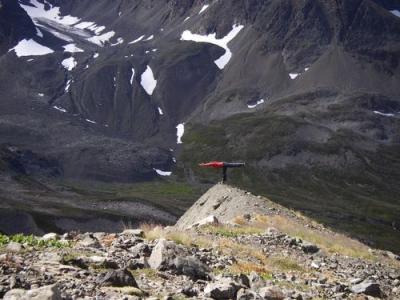
The glacier was up close and personal! We made our way closer to the glacier itself, slip-sliding along until we finally got to it and up on it.

Chris filled a water bottle full of glacier ice so we could have cold drinks for dinner. What a thrill to walk on a glacier!

There were shelves of ice with streams of water flowing down through it, but underneath the shelf it was totally melted away. It looked like these shelves would drop off at any time, so we backed away from the edge.
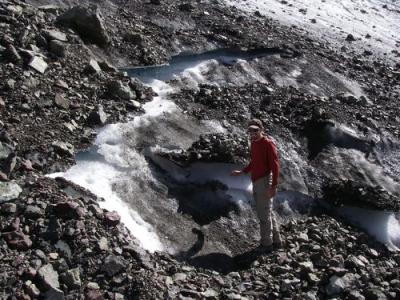
The hike down was again over loose broken rocks and was rough on the feet, but well worth the sites and sounds of the glaciers! Caleb boated to the other end of the lake to look at the mound of rocks that created the lake by blocking the path of the water flowing downhill. The boulders were as large as a Volkswagon, so Caleb did not think this was a glacial moraine, which is the pile of rock pushed in front of the glacier by the glacier’s tremendous weight and remains there after the glacier melts. It appeared that a rock slide from a mountain to the side of the lake may have blocked the path of the runoff water and created this stunning lake. So back to camp we ventured. Caleb checked the temperature logger on the computer to see if it had been taking readings, and it was working. So he set it to start and take readings for the coming year.
Next were preparations for dinner, clean-up, and an ice cold drink provided by Chris, cooled by glacier ice! What a treat. Then it was definitely time to head to the sleeping tents for the night. The fact that this time of year we have such long days allows the team to accomplish so much in a day. It also tires you out!
* *

